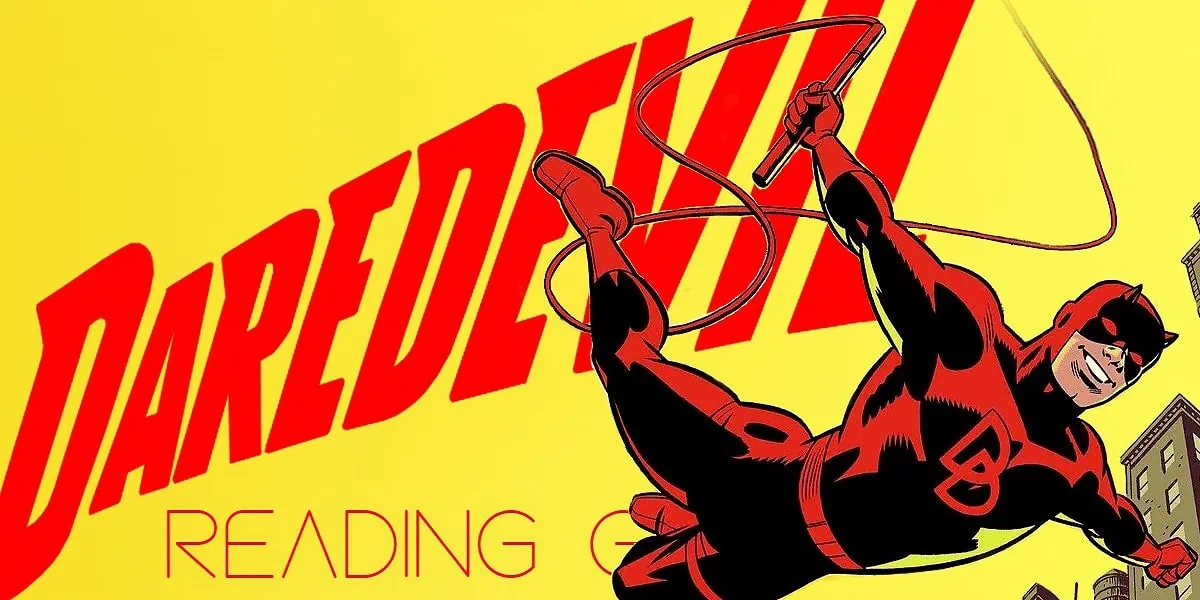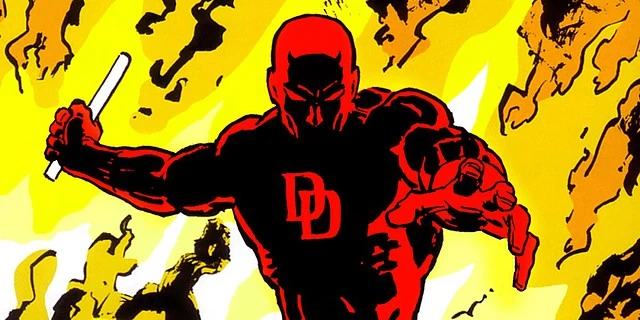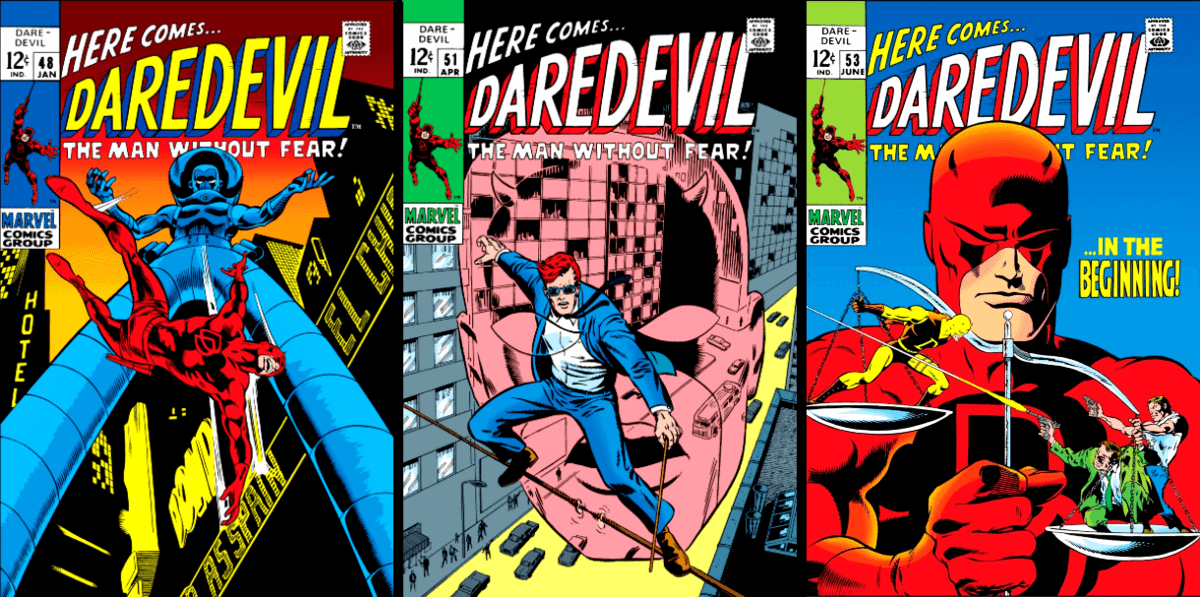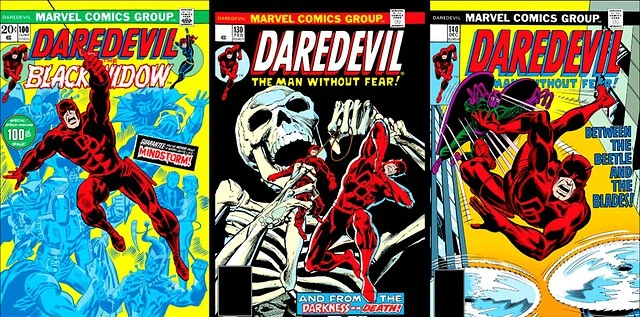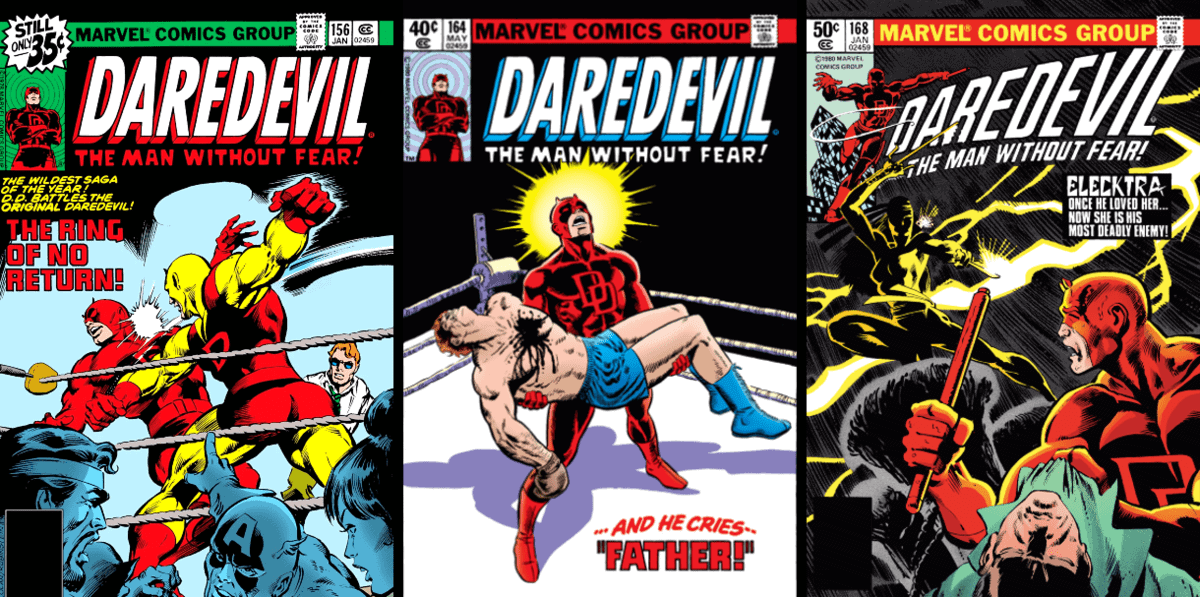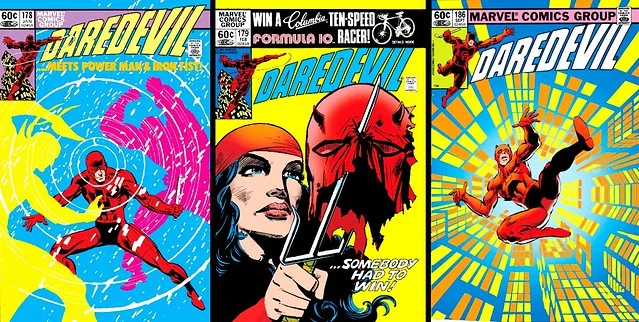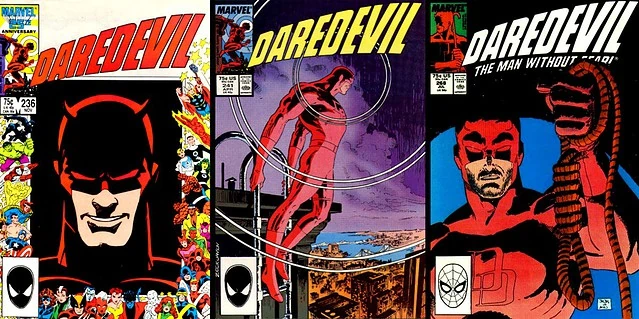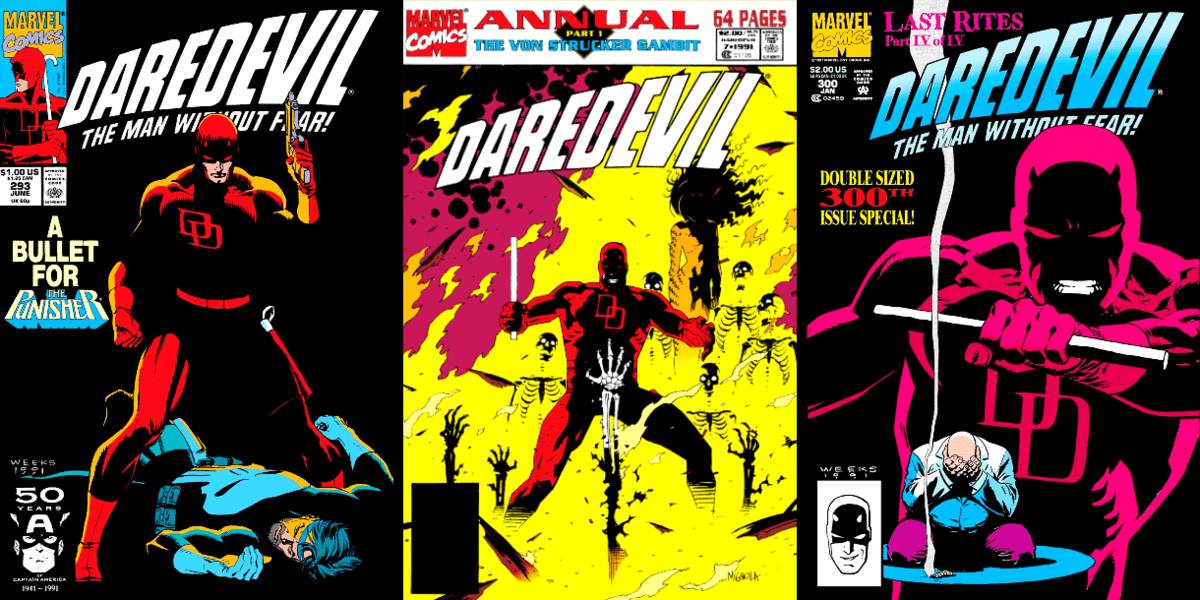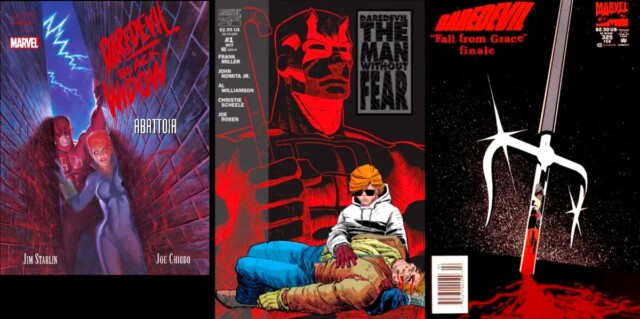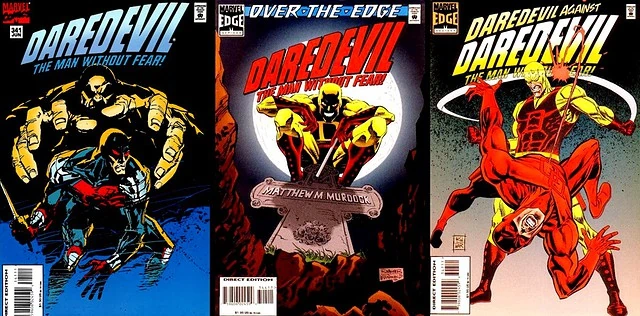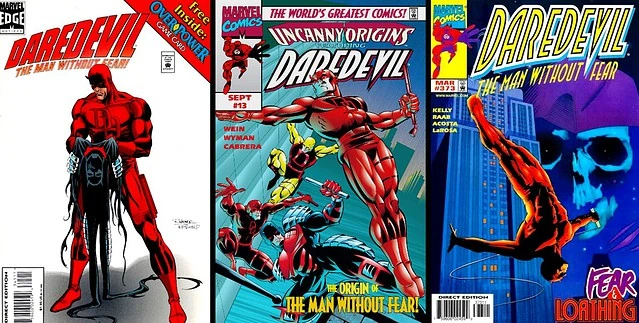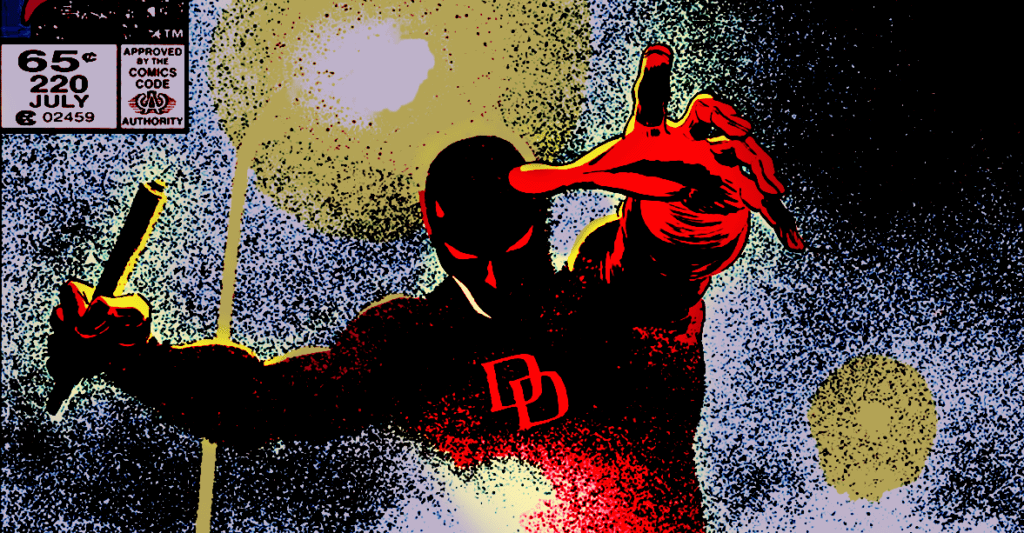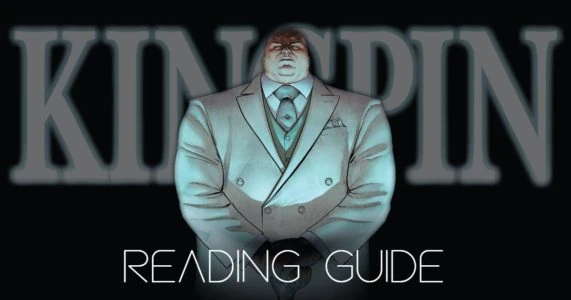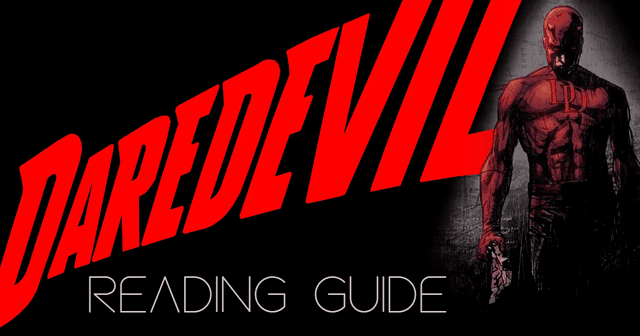Welcome to the classic Daredevil comics reading guide!
This is the best place to start for Daredevil’s formative years, including his iconic origin story, his first encounters with Kingpin and Elektra, and the definitive work of Frank Miller.
Daredevil comics quick start:
- Daredevil (1964) #165-191, 227-233 (Frank Miller)
- Daredevil (1964) #194-226 (Dennis O’Neil)
- Daredevil (1964) #236-291 (Ann Nocenti)
- Daredevil (1964) #297-304 (D. G. Chichester)
- Daredevil: The Man Without Fear (1993) #1-5 (Frank Miller)
Thanks to his complex internal conflicts, great villains, and consistently excellent creative teams, Daredevil has become one of the most popular characters in Marvel Comics.
Amazingly, his series on Netflix is also one of the best page-to-screen adaptations Marvel has ever done. After being immortalized by Charlie Cox‘s phenomenal portrayal, Matt Murdock is now taking the MCU by storm. Following his on-screen appearance in Spider-Man: No Way Home, Matt will next be seen in She-Hulk, Echo, and even another season of Daredevil in the future. Check out the modern Daredevil reading guide for Daredevil’s newest comic adventures!
But if you want to know how the Man Without Fear evolved into the icon he is today then read on to find out!
Also be sure to also check out our Marvel comics reading guides for She-Hulk and Echo! Happy reading!
Daredevil by Gene Colan (1960s)
Early Daredevil comics evolved out of the collaboration of all-star minds including Stan Lee, Bill Everett, Jack Kirby, Steve Ditko, Wally Wood, and John Romita Sr. After #51, Stan Lee delegated writing duties to Roy Thomas, who eventually passed it on to 18-year-old Gerry Conway for a more Silver Age, sci-fi take.
While these early issues are much lighter in tone than modern Daredevil comics, and don’t feature the most iconic villains and storylines, they’re still worth reading for nearly 100 issues of Gene Colan’s exquisite artwork. One of the definitive Daredevil artists of all time, Colan was also an active part of Stan Lee’s storytelling process during their 30-issue collaboration on Daredevil.
- Daredevil (1964) #1-50, Annual #1 by Stan Lee & Gene Colan
- #7 introduced the red Daredevil suit, first drawn by Wally Wood
- #12-14 drawn by Jack Kirby & John Romita Sr.
- #15-19 drawn by John Romita Sr.
- #18 co-written with Dennis O’Neil
- #20-50, Annual #1 drawn by Gene Colan
- #47 is the issue Stan Lee was most proud of in his career
- Daredevil (1964) #51-71 by Roy Thomas & Gene Colan
- Stan Lee stays as editor
- Daredevil (1964) #72-98 by Gerry Conway & Gene Colan
- In #81, Black Widow becomes a main character
- In #86, Matt Murdock moves to San Francisco
- In #93, retitled “Daredevil and the Black Widow” until #108
- #97 co-written with Steve Gerber
Extra reading:
-
- Amazing Spider-Man (1963) #16-18, 43, Annual #3
- X-Men (1963) #13
- Journey into Mystery (1952) #116
- Fantastic Four (1961) #39-40, 73, Annual #3
- Strange Tales (1951) #156
- Avengers (1963) #60, 82
- Iron Man (1968) #35-36
- Incredible Hulk (1962) #152-153
- Man-Thing (1974) #1
Daredevil by Bob Brown (1970s)
After Gene Colan left, the next era of Daredevil comics was mainly a time of experimentation. The 1970s saw various writers and artists on the title, leading to the creation of a few iconic characters like Bullseye. However, the most consistent element was the presence of artist William Robert Brown. After joining the series with #107, Bob Brown drew Daredevil for over 30 issues until he passed away in 1977.
Following Gerry Conway’s themes of science fiction and romance, Marv Wolfman grounds the title, unintentionally setting up the work Roger McKenzie and Frank Miller would do in the 1980s.
- Daredevil (1964) #97-123 by Steve Gerber & Bob Brown
- #97-98 co-written with Gerry Conway
- #99 crosses over with Avengers (1963) #110-111
- #103-106 drawn by Don Heck
- #110, 112, 116 drawn by Gene Colan
- #117 co-written by Chris Claremont
- #118 written by Gerry Conway
- #119-123 written by Tony Isabella
- Daredevil (1964) #124-143, Annual #4 by Marv Wolfman & Bob Brown
- #124 co-written by Len Wein, drawn by Gene Colan. Daredevil returns to Hell’s Kitchen
- #131 first appearance of Bullseye
- Daredevil (1964) #144-151 by Jim Shooter & Gil Kane
- #144-145 co-written with Gerry Conway, drawn by guest artists
- #149-150 co-written with Carmine Infantino
- #151 co-written with Roger McKenzie and Gil Kane, drawn by Gil Kane
Extra reading:
-
- Avengers (1963) #110-111, 159
- Giant-Size Defenders (1974) #3
- Defenders (1972) #24-25, 40
- Marvel Two-in-One (1974) #3
- Marvel Team-Up (1972) #25, 51, 56
- Deadly Hands of Kung Fu (1974) #8 [B Story]
- Thor (1966) #233
- Iron Man (1968) #89
- Ghost Rider (1973) #20
- Marvel Treasury Edition (1974) #13
- X-Men (1963) #98
- Marvel Comics Super Special (1977) #1
- Iron Fist (1975) #11
Daredevil by Frank Miller (1980s)
This is the era that re-defined Daredevil comics forever. Across a series of runs, Frank Miller shaped a new, gritty version of Daredevil with deep ties to Elektra, Kingpin, and the Hand. Miller’s work affected not only the future of the character but also his past, updating the origin story in a way that had never been seen before.
Acclaimed writers Roger McKenzie and Dennis O’Neil also had short, formative stints with the character alongside the Miller runs. McKenzie in particular was responsible for establishing the darker tone that Miller took further.
- Daredevil (1964) #151-166 by Roger McKenzie, Gene Colan, and Frank Miller
- #151 co-written with Jim Shooter and Gil Kane, drawn by Gil Kane
- #152 drawn by Carmine Infantino
- #153 first appearance of Daily Bugle reporter Ben Urich
- #153-157 drawn by Gene Colan
- #158-166 drawn by Frank Miller
- #165-166 co-written with Frank Miller
- Daredevil (1964) #165-191 by Frank Miller & Klaus Janson
- #165-166 co-written with Roger McKenzie
- #165-184 drawn by Frank Miller
- #167 guest-written by David Michelinie
- #168 introduces Elektra
- #178-182 “The Last Hand” by Frank Miller
- #181 co-drawn with Klaus Janson, also a major Bullseye/Elektra story
- #183 co-written with Roger McKenzie
- #185-191 drawn by Klaus Janson
- #191 co-drawn by Frank Miller, the famous “Roulette” issue
- What If? (1977) #35
- “What If Elektra Had Lived?”
- Daredevil (1964) #192-226 by Dennis O’Neil & David Mazzucchelli
- #192-197 drawn by Klaus Janson
- #197-207 drawn by William Johnson
- #208-226 drawn by David Mazzucchelli
- #226 co-written with Frank Miller
- Daredevil (1964) #226-233 by Frank Miller & David Mazzucchelli
- #226 co-written with Dennis O’Neil
- #227 “Apocalypse.” Winner of the 1986 Kirby Award for Best Single Issue
- #227-231 “Born Again.” Winner of the 1987 Kirby Award for Best Writer/Artist team
- Daredevil: Love and War (1986) by Frank Miller & Bill Sienkiewicz
- Also known as Marvel Graphic Novel #24
Extra reading:
-
- Human Fly (1977) #9
- Marvel Two-in-One (1974) #37-40, 69, 78, 96
- Thor (1966) #271
- Marvel Team-Up (1972) #73, 107, 123, 140-141, Annual #4
- Captain America (1968) #234-236
- Peter Parker, The Spectacular Spider-Man (1976) #26-28
- Avengers (1963) #190-191
- Marvel Treasury Edition (1974) #25
- Captain America (1968) #250
- Defenders (1972) #88-91, 103-107
- Amazing Spider-Man (1963) #218-219
- Marvel Fanfare (1982) #1, 7, 15, 23
- Moon Knight (1980) #13
- Rom (1979) #23
- Marvel Graphic Novel (1981) #1
- Power Man and Iron Fist (1980) #77
- Fantastic Four (1961) #242-243, 255, 281, Annual #13
- Contest of Champions (1982) #1-3
- Dazzler (1981) #21
- Incredible Hulk (1962) #277-279
- Iron Man (1968) #169
- Incredible Hulk (1962) #293, 300
- Amazing Spider-Man (1963) #267, 277
- Secret Wars II (1985) #3
- Peter Parker, The Spectacular Spider-Man (1976) #107-110
- Marvel Age Annual (1985) #1
Daredevil by Ann Nocenti (late 1980s)
Writer Ann Nocenti immediately followed Miller with her own solid run. Mainly drawn by John Romita Jr., Nocenti’s long tenure includes some of Matt Murdock’s most beloved adventures, including “Typhoid Mary” and the storyline where Bullseye impersonated Daredevil.
- Daredevil (1964) #234-249 by Ann Nocenti
- #234-235 drawn by Steve Ditko
- #237-244 drawn by Louis Williams
- Daredevil (1964) #250-282 by Ann Nocenti & John Romita Jr.
- #254-263 “Typhoid Mary” storyline
- #266 co-written by John Romita Jr.
- Daredevil (1964) #283-291 by Ann Nocenti, Lee Weeks, and Kieron Dwyer
- #284-290 Bullseye impersonates Daredevil, inspiring season three of the Netflix show
- Daredevil (1964) Annuals #5-7 by Gregory Wright
- What If…? (1989) #2 by Danny Fingeroth & Greg Capullo
- “What If… Daredevil Had Killed The Kingpin?”
Extra reading:
-
- Power Man and Iron Fist (1980) #125
- Marvel Fanfare (1982) #27, 31
- Marvel Graphic Novel (1981) #24, 27
- Amazing Spider-Man (1963) #286-288
- Peter Parker, The Spectacular Spider-Man (1976) #128
- Marvel Comics Presents (1988) #4-5, 19, 49
- Incredible Hulk (1962) #346
- The Punisher (1987) #10
- Amazing Spider-Man Annual (1964) #22
- Thor (1966) #392-395
- Punisher War Journal (1988) #1-3
- Saga of the Sub-Mariner (1988) #9
- Wolverine (1988) #17
- Marvel Graphic Novel (1981) #58, 61
- Captain America (1968) #374-376
- Incredible Hulk Annual (1968) #16
- Marvel Super-Heroes (1990) #2, 4
- Avengers (1963) #332-333
- Marvel Comics Presents (1988) #69-72 [C Stories]
Daredevil by D. G. Chichester (early 1990s)
Dan Chichester’s run heralds the beginning of the end for early Daredevil. Starting his run with the legendary “Last Rites” arc, Chichester wrote 40 issues of Daredevil comics but never reached the same highs again. Chichester is also famous for the “Fall From Grace” storyline which introduced new black Daredevil armor, Matt’s first costume redesign since the 1960s.
More importantly, this era features Frank Miller & John Romita Jr.’s The Man Without Fear. Frank Miller’s definitive origin reboot for Daredevil has become one of the most legendary superhero miniseries of all time, and heavily inspired season one of the Netflix show.
- Daredevil (1964) #292-332 by D. G. Chichester, Lee Weeks, and Scott McDaniel
- #292-300 drawn by Lee Weeks
- #297-300 famous “Last Rites” arc
- #305-332 drawn by Scott McDaniel
- #319-325 “Fall From Grace” arc
- Daredevil: Fall From Grace (1994) #1
- Takes place after #325
- Daredevil (1964) #333-337, Annual #8-10 by Gregory Wright
- #333-337 drawn by Tom Grindberg
- Annuals drawn by various artists
- Daredevil (1964) #338-342 by D. G. Chichester
- #338-340 drawn by Alexander Jubran
- #341-342 drawn by Keith Pollard
- Daredevil: The Man Without Fear (1993) #1-5 by Frank Miller & John Romita Jr.
- “Favorite Limited Comic-Book Series” Award in the 1993 Comics Buyer’s Guide Fan Awards
- Daredevil/Black Widow: Abattoir (1993) #1
- Daredevil vs. Vapora (1993) #1
- Elektra: Root of Evil (1995) #1-2
Extra reading:
-
- Marvel Comics Presents (1988) #81, 91, 93, 136 [D Stories]
- Slapstick (1992) #4
- Marvel Fanfare (1982) #60 [C Story]
- Marvel Holiday Special (1991) #1-2
- Marvel Super-Heroes Annual UK (1990) 1992
- Darkhawk (1991) #6
- Doctor Strange: Sorcerer Supreme (1988) #40
- Marvel: 1991 the Year in Review (1992) #1
- Spider-Man Special Edition (1992) #1
- Ghost Rider (1990) #36, 61
- Punisher War Journal (1988) #46-47, 57-58
- Nomad (1992) #6
- Infinity War (1992) #2-4
- Fantastic Four (1961) #367-378
- Marc Spector: Moon Knight (1989) #41, 43, 57
- Spider-Man Unlimited (1993) #2, 6
- Marvel Graphic Novel (1981) #75
- Infinity Crusade (1993) #1-6
- Thor (1966) #464
- Web of Spider-Man (1985) #104-106
- Doctor Strange: Sorcerer Supreme (1988) #55
- Alpha Flight (1983) #127
- Real Heroes (1994) #3
- Marvels (1994) #2, 4
- Marvel Comics Presents (1988) #150-151
- Silver Sable and the Wild Pack (1992) #23, 30
- Marvel Double Feature … Thunderstrike/Code Blue (1994) #16 [B Story]
- The Spectacular Spider-Man (1988) #218-219
- Amazing Spider-Man (1963) #396
- Spider-Man: The Power of Terror (1995) #2-4
Daredevil comics by J. M. DeMatteis, Karl Kesel, and Joe Kelly (late 1990s)
At the latter half of the 1990s, the title struggled to hold a stable creative team. Matt Murdock reverted back to his more light-hearted roots under the pen of writers like J. M. DeMatteis, Karl Kesel, and Joe Kelly, to mixed response. While there are plenty of fans of this era, the series was clearly ready for Kevin Smith’s modern relaunch in 1998.
- Daredevil (1964) #343-352
- #343 by Warren Ellis & Keith Pollard
- #344-347 by J.M. DeMatteis & Ron Wagner, ties into the “Over the Edge“ event
- #348-349 by J.M. DeMatteis & Cary Nord
- #351-351 drawn by Shawn McManus
- Daredevil (1964) #353-364 by Karl Kesel & Cary Nord
- #358 by Joe Kelly & Pasqual Ferry
- #363 drawn by Gene Colan
- Daredevil (1964) #365-375, -1 by Joe Kelly, Gene Colan & Ariel Olivetti
- #365 drawn by Cary Nord
- #366-370, -1 drawn by Gene Colan
- #369-375 drawn by Ariel Olivetti
- Daredevil/Deadpool ’97 (1997) #1
- Elektra (1996) #-1, 1-3, 10-13
- Kingpin (1997) #1
- Daredevil (1964) #376-380 by Scott Lobdell, Cully Hammer, and Tom Morgan
- #380 by D. G. Chichester & Lee Weeks
Extra reading:
-
- Over the Edge Event:
- Double Edge: Omega (1995) #1
- Incredible Hulk (1962) #434
- Over the Edge (1995) #1, 6, 10
- DC Versus Marvel (1995) #1
- The Punisher (1995) #4
- Green Goblin (1995) #6
- Spider-Man Unlimited (1993) #13, 18
- Marvel: Heroes and Legends (1996) #1
- Spider-Man (1990) #74
- DC/Marvel: All Access (1997) #2
- Tales of the Marvel Universe (1997) #1 [B Story]
- Code of Honor (1997) #1-4
- Venom: On Trial (1997) #1-3
- The Punisher (1995) #17
- Bug (1997) #1
- Silver Surfer (1987) #128-129
- Marvel Valentine Special (1997) #1 [B Story]
- Thunderbolts (1997) #8, Annual 1997
- Unlimited Access (1997) #2
- Uncanny Origins (1996) #13
- Untold Tales of Spider-Man ’97 (1997) #1
- Ka-Zar (1997) #8
- Amazing Spider-Man (1963) #429, 438, Annual 1998
- Uncanny X-Men (1981) #351
- Thunderbolts (1997) #10
- Shadows and Light (1998) #1 [D Story]
- Cable (1993) #55
- Spider-Man: Made Men (1998) #1
- Nighthawk (1998) #1-3
- Avengers (1998) #10-11
- Amazing Spider-Man (1999) #1
- Over the Edge Event:
And that’s early Daredevil comics! How much have you already read? How much are you excited to check out now? Let me know on Twitter @vinwriteswords and remember to follow the site @MyCosmicCircus as we continue to prepare for Daredevil to take over the MCU! To learn more about Daredevil Matt Murdock, visit the official Marvel page.
Modern Daredevil Reading Guide: 1998-2002
All images courtesy of Marvel Comics.

